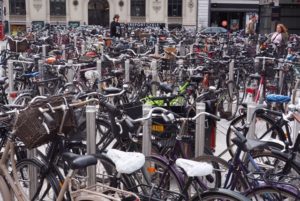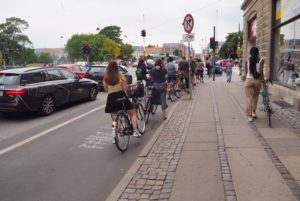Ever wonder why our best intentions to “keep it simple, stupid” just seem to fail us? I wish life and change were simple. I’m not alone.
- Many communities: wish for more affordable housing, less traffic congestion, better economic and health outcomes for all demographic groups, more cohesive and diverse communities;
- Companies: envision growth without losing a small-company culture; a great talent pool ready to lead; affordable health benefits; positive community impact; or maybe a simple, a quick way for a founder to let go and retire.
Traveling to Europe recently brought into sharp focus how leaders, both civic and business, too often see the world through their ‘wish’ lenses. It’s understandable. We have a noble vision and a drive for results. We see stellar examples in the world that reinforce the vision and the drive. The contradiction is that vision is long-term requiring sustained energy and multiple paths; and drive for results implies “now” and simple proclamations, posters and isolated actions.
Noble Work
Community Wishing
We were in Copenhagen and the first thing we saw on the ride into town were the bicycles, thousands of them. At the metro/bus/train  station we saw ONLY bicycles parked in masses. Along the streets, parked bikes leaned along walls, bunched in alleys and clogged stairwells. I read that bicycles account for 63% of all transit.
station we saw ONLY bicycles parked in masses. Along the streets, parked bikes leaned along walls, bunched in alleys and clogged stairwells. I read that bicycles account for 63% of all transit.
At stop lights the bike-rider queues were long and wide, but orderly and patient; no one road where pedestrians walked!
I thought of back home. My city struggles with growth that impacts traffic and housing and service/ infrastructure budgets. The City Council has a long wish list. For example, they implemented a Living Laboratory street project installing dedicated bike lanes thus reducing car lanes on key streets. The intent (read ‘wish’) was to provide safer and more direct bike lanes thus encouraging more biking, less driving and reduced carbon emissions.
It seems a straightforward idea. Proclaim a noble vision and install a solution. Without enough systems-thinking or thoughtful change leadership, the reaction was predictable: an immediate uproar from drivers and business-owners. The experiment was curtailed within a month while the debate continues to rage. This month they are repeating the flawed process with a new pilot called Green Streets. Stand by for the fireworks.
Business Leaders’ Wishes
Growing businesses, like growing towns, have urgent visions too. A CEO critically needs senior, experienced leaders to manage more strategically and tackle complex goals and plans. He wishes to develop future leaders from within and create meaningful career paths, but the history is one of external senior-hires that make the top heavy and the middle see no future. What else, besides an investment in an executive course, will he need to do? What are the HR systems and programs to invest in? What is the appetite for risk and the commitment to coaching that comes with development? There are multiple gears to synchronize and levers to pull in order to realize the wish.
A business owner in her 60’s thinks about selling and leaving a sustainable business for her people and customers. What else, besides the wish and perhaps a meeting with her tax planner, must she plan for? What is she willing to invest in e.g. what processes must be designed or improved; how strong is her talent bench? How must her role shift? Will she do the hard work over two to three years-time to understand and act on her financial and life goals and the value-producers for her business?
Noble Intentions AND Hard Work
Audacious visions require systems thinking and that’s hard work—to get your head around, and to prioritize, which levers to pull.
Why are bicycles a way of life in Copenhagen, Amsterdam and other European cities? There is a system of factors that influence the behavior:
- culture (a mindset that bikes are for transit vs. recreation–the average trip is 2 miles and most trips are 15 min or less) and shared values that focus on the collective good vs. individualism (riders actually wait for lights vs. racing forward as if in the Tour de France);
- infrastructure factors (diverse mass transit, subsidized fares, street design that separates cars, bikes and pedestrians; and zoning);
- historical and external components (a compact city laid out 800 years ago with updated policy to support growth, density and affordable housing.)
What allows for growth without losing your company culture? What develops leaders before you have a critical need? What levers do you pull to prepare your company to be sold if your vision is not only a profitable sale but taking care of your people and leaving a sustainable business? (I hope you will visit my book, Exit Signs, for more on this.)
We wish change and life were simple. We hope that by modifying just one or two of the system factors we can effect change or transform behavior. And sometimes we are fortunate, and the change we want starts to happen. But without a change-plan that addresses multiple systems and change factors like power, mind-set, engagement, and measures/rewards, noble visions often fall short.
Start here
- Articulate your noble vision in terms of what you value and what you want to see in practice. Tell the what and the why.
- Define the system – draw a system or causal loop diagram – showing the components involved (in traffic congestion or in building leadership capacity) and their inter-relationship. Look for how one factor change will likely impact or require other factors to change, and, how external factors play a role. Start simply but think deeply. (See this link for simple instructions to get started.)
- Understand the stakeholders in that system and how to engage them to work through predictable resistance and to mobilize commitment.
- Draw up the long-term plan for what will change (and what won’t) and how you will personally champion and stay engaged in the transition work.
- Pro-actively define the warning signs that signal you are losing momentum. Monitor your progress and communicate.
With your vision, let this be your mantra “Simple over Simplistic; Systems over Isolated Solutions.”
What thinking and hard work will help you realize your noble intent and vision?

